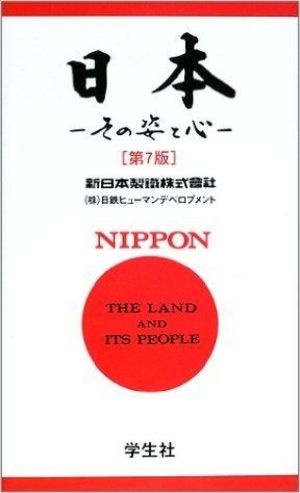
No matter how many years you have stayed in Japan, some aspects of the country’s culture may still be a mystery to you. If you want to dig deeper into Japanese culture and history, there’s an excellent book available, titled "NIPPON The Land and Its People.” It covers a wide variety of topics on Japan, including geography, history, politics, economics, society, technology, and culture, and is available in both Japanese and English.

The book, first published in 1982 and in its 10th edition, has sold more than one million copies and has long been a best-seller. It is used for training the employees of large Japanese corporations with oversea branches as well as those at the U.S. Embassy and members of the U.S. forces in Japan.
The idea for the book sprung from the needs of Nippon Steel employees who were stationed in oversea branches. They were often asked about Japanese culture and customs but had trouble answering because they realized that they didn’t know their country’s history and culture well enough.
So, a group of young workers assembled dozens of frequently asked questions and wrote a booklet to answer them. Although the booklet was used only by Nippon Steel employees at first, it soon went viral among Japanese people living overseas and was published as a book in 1982. Today, the book is still being added to and edited by Nippon Steel employees who have experience working abroad.
Here are a few of the more popular questions and answers:
--How “bushi” or samurai warriors organized their government?
Warriors employed by the nobility to keep the peasants under control took advantage of their position of direct control over the farmers to greatly expand their power, until late in the twelfth century they were able to replace the nobility as the de facto leaders of the country. The rule of the warrior class lasted nearly seven hundred years, finally coming to an end in the latter half of the nineteenth century.
Formally, the leading warrior would be appointed by the emperor as his “shogun in charge of conquering barbarian territories” and with this designation would set up the central government under the shogun (shogunate or bakufu) and take leadership over the feudal lords (daimyo) in the various part of the country. In return for the shogun’s recognition of their right to rule over their territory and people, and lords would pledge their loyalty to the shogun.
--What “bushido” thinks is important?
Bushido is the moral code of the samurai class. Based on Confucian ideas, it originated in the Kamakura period and reached perfection in the Edo period (1603-1867). It puts emphasis on such virtues as loyalty, self-sacrifice, trustworthiness, sense of shame, refined propriety, integrity, austerity, thriftiness, warrior sprit, honor, sentiment, compassion (among samurai), affection for the weak and female, and so forth.
--Why Tokugawa shogunate succeeded as long as 260 years?
The Tokugawa shogunate succeeded in putting a stop to regional conflicts by establishing the shogunate and han (regional domain) system in which the country was divided into many domains each of which a shogun-appointed lord governed. It also implemented a caste system that ranked warriors at the top, followed by farmers, artisans and trademen, and strictly prohibited migration between classes. This gave it total control over the farmers at the core of the country’s rice-dominated economy.
In 1639, the shogunate broke off all relations with foreign countries, prohibited foreign travel and entered an era of isolation. The shogunate-domain political system, along with a land-rice dominated economic system, gave theTokugawa shugunate overwhelming financial power that it used to keep the feudal lords under tight political and military control and maintain a long peaceful period throughout the country. With peace came industrial and commercial development, cultural progress and dramatic advances in education, thus laying the foundation for the ensuing period of development into a modern nation.
--Why did “bushi” used to slit their bellied to commit suicide?
Seppuku is a ritual form of suicide that used to be practiced by members of samurai class to show that they accepted responsibility for their actions. It said to have its beginnings toward the end of the Heian Period, about one thousand years ago.
In expressing respect for someone of high moral character, the Japanese may use the phrase “person of determined and strong stomach.” In feudal times warriors used to respect the abdomen because it was considered to be the receptacle of the spirit, so when they assumed responsibility as warriors for some action or course of conduct and had to die, they would cut open their abdomen.
--What Japanese swords mean to Japanese?
The Japanese sword has a curved blade with a single cutting edge. Made by a special process that include hammer-forging, hardening and quenching hot raw steel made by smelting sand iron, the sword is characterized by its great spring-like toughness and its extremely sharp cutting edge.
As the sword was considered to be the very soul of the samurai and became the symbol of the warrior class, many specimens show superb craftsmanship. Since the end of World War 2, the Japanese sword has come to be regarded sorely as an object of art, often to be treasured for a sense of tranquility found in its cold, serene beauty.
--What was the literacy rate in the Edo period?
High respect for education had become a characteristic of Japanese society from no later than the Edo period (1603-1867), well before the days of rapid modernization that started with the Meiji Restoration in 1867. Study of reading, writing, and arithmetic was widespread during the Edo period, so that about half of the population, including farmers and ordinary townspeople, could read and write by the time of the Restoration. This level of literacy was rare anywhere in the world at the time.
